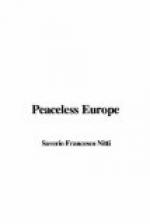6. Germany has not to discuss, only to pay. Let time illustrate what is at present unforeseeable, etc. etc.
If we exclude the third means of payment Germany has two ways open to her. First of all she can give goods. What goods? When we speak of goods we really mean coal. Now, as we have seen, according to the treaty Germany must furnish for ten years to Belgium, Italy, and France especially quantities of coal, which in the first five years run from 39-1/2 to 42 millions of tons, and in the following five years come to a maximum of about 32 millions. And all this when she has lost the Saar coalfields and is faced with the threatening situation in Upper Silesia.
Germany’s exports reached their maximum in 1913, when the figures touched 10,097 millions of marks, excluding precious metals. Grouping exports and imports in categories, the millions of marks were distributed as follows:
Imports. Exports.
Foodstuffs 2,759 1,035 Live animals 289 7.4 Raw materials 5,003 1,518 Semi-manufactured goods 5,003 1,139 Manufactured goods 1,478 6,395
About one-fifth of the entire exports was in iron and machine products (1,337 [mil.] articles in iron, 680 machines); 722 millions from coal (as against imports of other qualities of 289), 658 millions of chemical products and drugs, 446 from cotton, 298 paint, 290 techno-electrical productions, etc.
What goods can Germany give in payment of the indemnity? We have seen how she has lost a very large part of her iron and a considerable quantity of her coal.
All the economic force of Germany was based upon:
(a) The proper use of her reserves of coal and iron, which allowed her to develop enormously those industries which are based on these two elements.
(b) On her transport and tariff system, which enabled her to fight any competition.
(c) On her potent overseas commercial organization.
Now, by effect of the treaty, these three great forces have been entirely or in part destroyed.
What goods can Germany give in payment of the indemnity, and what goods can she offer without ruining the internal production of the Entente countries? Let us suppose that Germany gives machines, colours, wagons, locomotives, etc. Then for this very fact the countries of the Entente, already suffering by unemployment, would soon see their factories obliged to shut down. Germany must therefore, above all, give raw materials; but since she is herself a country that imports raw materials, and has an enormous and dense population, she is herself obliged to import raw materials for the fundamental needs of her existence.
If we examine Germany’s commerce in the five years prior to the War—that is, in the five years of her greatest boom—we shall find that the imports always exceeded the exports. In the two years before the War, 1912 and 1913, the imports were respectively 10,691 and 10,770 millions, and the exports 8,956 and 10,097 millions. In some years the difference even exceeded two milliards, and was compensated by credits abroad, with the payment of freights and with the remittances (always considerable) of the German emigrants. All this is lost.




